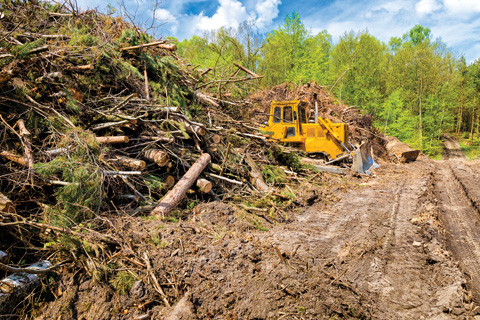It’s an undertaking that most folks will complete only once or twice in a lifetime, and building a log or timber home, they find, is a journey, a process that involves several distinct steps. An understanding of those steps and how they come together in the finished product is essential.
“There are some things we run into that nobody can control,” acknowledges Brad Mercer, sales manager at Timberhaven Log & Timber Homes. “Unfortunately, the weather can play a part in the process. People will often ask how long the building process takes. I explain that it can be six months to a year, but that all depends. There are sometimes issues with bank financing, delivering materials, and someone will say, ‘I would like to be in by October for hunting season,’ but being able to say how long it takes to get from napkin sketches to fruition is always a challenge.”
An understanding of the process, therefore, helps set expectations and assists owners in preparing for the great “unknown.” Take some time; consider what the long-term goal of log or timber home ownership is. What are the necessities, and what are the essential elements versus those that would be nice to include?
Jeff Clements, vice president of Honest Abe Log Homes, offers an established road map to success. First, he says, do some research. This critical initial step is followed by: purchase land early; set goals and establish a timeline; create a budget and get prequalified; start a preliminary design and wish list; order blueprints and apply for a loan; get construction estimates and interview builders; choose a general contractor; finalize the loan; order the package and place the deposit.

IStock.com/ewg3D
Once these steps are completed, construction begins with clearing the lot and preparing the site for building. This may involve extensive moving of dirt to establish a level foundation space. Remember, the more site preparation involved, the more expensive the project will be—and there is no real “value” return on this investment when the project is completed. Therefore, choose the site carefully.
“First comes site preparation,” says Mercer. “Then make sure your builder has access to the site. Get the foundation in after you have determined that you will have a basement, slab, crawlspace, or whatever. Materials have to be on hand at that point, and this will allow subflooring and framing and sheathing to be done. This gives a lot of structural integrity and allows the log stack to begin in a log home construction project. Once the log stack is done, the exterior walls are pretty much completed except for the sealing.”
“Once you get the home under roof in the weathertight stage, things look pretty complete from the outside, and the homeowner has seen a lot of progress in a relatively short time. The home may even look completed from the outside,” Mercer continues. “But there is still a lot of work to do on the interior. People get really excited that the home is taking shape, but wow! There are still a lot of things to finish and they may get anxious if they perceive a slowdown. Remember that the installation of electrical components, lighting, floorcovering, painting, plumbing fixtures, cabinetry, and more has to take place, and then the polyurethane coating of surfaces has to be done.”
Landscaping is usually the final step in the construction process. Look for elements that complement the structure, that offer contrast and color in the right amount. Don’t plant too close to the structure, which is an open invitation to insect infestation.
Mercer notes that a primary difference in construction from log to timber homes involves the exterior walls. He advises that setting up timber frame walls includes the application of panels or other materials, and while there is no insulation in solid log walls, timber frame walls will usually require some. From the completion of the walls, he says, timber frame construction is quite similar to conventional home building.

iStock.com/Dovapi
Of course, much of the time and energy involved in the construction project takes place before the first shovel of dirt is turned. Clements says research is important in setting a baseline of preferences. “Take notes,” he suggests. “There is more than one way to build a log home. Once you’ve identified a few companies to focus on, start digging into the details. Talk with their staff, visit their manufacturing headquarters, see the product firsthand and attend seminars.”
When settling on a site for that dream log or timber home, consider zoning restrictions, subdivision covenants, and building codes. Better safe than sorry when it comes to compliance! If the land has been owned for a few years, there may be appreciation in value, or equity that will boost the project appraisal and allow for a higher loan amount if financing is needed. Stick to the budget. Little alterations or “change orders” can add up quickly. Set up a contingency fund to pay for the inevitable unforeseen expense. When the timeline is set, realize that there will be deviations.
“From my perspective, we do everything we can to ensure that something doesn’t happen,” adds Mercer. “But there are things that nobody can control. One of the most important things to do is work with an experienced log home company and sales person and a good, experienced builder. Strong communication between all parties is really important. The pre-planning goes a long way, and have a backup plan if something does happen to the timeline. In other words, if we do have bad weather can we be weathertight as soon as possible so that work can continue inside if the weather turns. This is particularly important if you are doing a “winter build.” Also remember that contractors move at the pace allowed by funding. If there is a bank loan—and the process from application to appraisal to closing can take a while—then the builder has to wait for inspections to approve disbursements on the loan funding. This can take a couple of days sometimes.”
For any prospective log or timber home owner, the watchwords are “patience” and “perspective.” Steady progress wins the construction race for everyone involved, helps to avoid mistakes, and leads to the desired results. The devil may just lie in the details, but preparation and a strong partnership minimize headaches.

